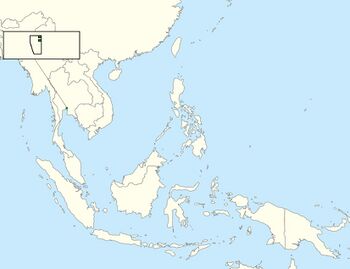Fiestian Empire
Fiestian Empire จักรวรรดิเฟียสเตียน (Thai) | |||||||
|---|---|---|---|---|---|---|---|
| Motto: Angels save our king | |||||||
| Anthem: Angels and our Emperor | |||||||
 | |||||||
| Capital and largest city | City of Fiesta | ||||||
| Official languages | English Thai | ||||||
| Ethnic groups (2022) | Thai (100%) | ||||||
| Religion | Buddhist (100%) | ||||||
| Demonym(s) | Fiestian | ||||||
| Government | Absolute Monarchy | ||||||
• Emperor | Emperor Fiesta | ||||||
| Legislature | none | ||||||
| Establishment | |||||||
• Fiestian Empire | 13 August 2022 | ||||||
| Area | |||||||
• Total | 0.0000634 km2 (2.45×10−5 sq mi) | ||||||
• Water (%) | 0% | ||||||
| Population | |||||||
• 2022 census | 6 | ||||||
| Currency | Baht | ||||||
| Time zone | UTC+7 (IDT) | ||||||
| Calling code | +66 | ||||||
| |||||||
| Today part of | Kingdom of Parvussia | ||||||
The Fiestian Empire (จักรวรรดิเฟียสเตียน) was initially founded by Fiesta, who later became known as King Fiesta I in the present day. It is important to note that the Fiestian Empire transitioned into a dependent state of the Nesta Empire before ultimately being succeeded by the Kingdom of Parvussia. The historical evolution of these political entities reflects a complex interplay of alliances, conflicts, and shifts in sovereignty within the micronational context.
History
The Fiestian Empire (จักรวรรดิเฟียสเตียน) was originally conceptualized by Fiesta, who aspired to establish his monarchy. Originating as a fictional nation in the virtual world of Roblox, Fiesta decided to bring his micronational vision to life by creating the "Fiestian Empire." During its inception, the Fiestian Empire adhered to an ideology rooted in Feudalism. Fiesta appointed nobles, ranging from Barons to Dukes, allocating lands to them and charging them with the responsibility of defending their respective territories.
However, internal strife emerged as some nobles rebelled against Emperor Fiesta's rule, driven by aspirations for imperial authority. In response, Emperor Fiesta deployed his army to quell the rebellion, but they suffered defeat. Faced with the desperate situation, Emperor Fiesta contemplated abdicating the throne in favor of Toeik, the 1st Duke of Fiesta (now Toeik, the 1st Duke of Faxeria), who, however, declined the offer. Encouraged by loyal nobles to persevere, Emperor Fiesta rallied another troop to protect the empire, yet they were unable to withstand the challenges, resulting in significant losses.
Amidst this turmoil, Emperor Nesta of the Nesta Empire seized the opportunity and invaded Emperor Fiesta's stronghold, attempting to assassinate him. Fortunately, Emperor Fiesta survived the attempt, leading him to declare war on the Nesta Empire. This declaration marked the onset of a war between the Fiestian Empire and the Nesta Empire, intensifying the geopolitical landscape between these micronations.
The first war between the Nesta Empire and the Fiestian Empire
After the declaration of war on the Fiestian Empire, Fiestian forces initiated a campaign to attack and invade the territories of the Nesta Empire. However, the initial assault faced a significant setback as all of the soldiers deployed became wounded and were unable to continue the fight. Faced with this critical situation, Emperor Fiesta and the nobles made the crucial decision to personally join the war effort and engage in combat alongside the remaining forces against the Nesta Empire's army. This decision was prompted by the dire circumstances in which the regular soldiers were incapacitated.
The Fiestian Empire's forces, despite their lack of experience compared to the seasoned Nesta Empire's army, pressed on in a bid to defend their territories and uphold their sovereignty. The involvement of the Emperor and nobles on the front lines underscored the determination to face the challenges head-on, despite the odds stacked against them.
Fall of the empire
Facing insurmountable challenges and recognizing the incapacity to continue the conflict, the Fiestian Empire made the difficult decision to surrender to the Nesta Empire. The significant factor contributing to this surrender was the widespread injuries suffered by the soldiers, including the king and nobles. Additionally, the limited experience of the Fiestian Empire's army in both offensive and defensive strategies played a crucial role in this decision.
As a consequence of the surrender, the Fiestian Empire transitioned into a colonial status under the dominion of the Nesta Empire. This marked a significant shift in the geopolitical landscape, with the Nesta Empire now exerting control over the territories and affairs of the former Fiestian Empire. The surrender and subsequent colonial status represented a period of subjugation for the Fiestian Empire within the larger framework of the Nesta Empire's influence.

